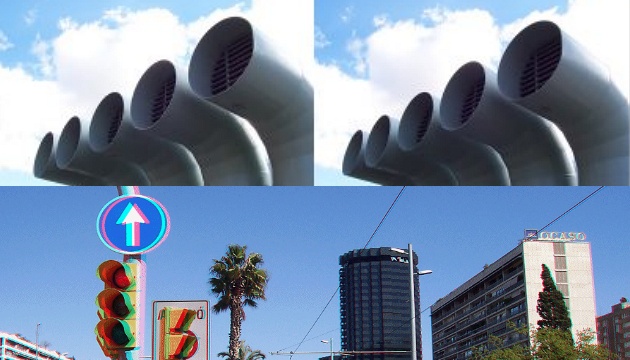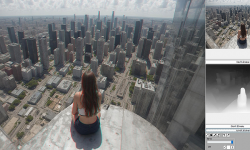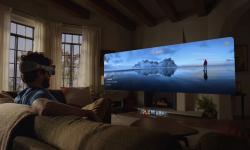Let's remember that if the observer is to see the image as spatial, it is necessary for each eye to see its own image. The images for the left and right eye must be different, and their difference contains information about the location of the objects in space - and therefore the depth of the image. It makes us perceive the image as 3D.
So the question is how to present each eye with its own image. Basically, there are two possibilities - either each eye actually has its own image - for example, on its own display, or both eyes have one common image, but each sees something different in it. For example, because the observer is wearing blue-red glasses and each eye sees only the colours of the image that its coloured glass will allow through.
Stereoscopic pair
The simplest method in terms of creation is to place the images for the left and right eye side by side. For example, by adding the two photos (left and right) together in a graphics editor. However, observing the resulting image is not entirely straightforward. It is necessary to focus the eyes as if they were observing a point far behind the screen while keeping them in focus on the screen. Looking into the distance is important so that each eye sees only the image intended for it, and focusing is important so that the image seen is not blurred. In order to observe a stereoscopic pair at all, the images must not be too large - otherwise, if they were close to the observer, his eyes would have to be directed away from each other.
There are also various aids for observing images placed side by side, including specialised viewers, with which the images can then be observed on a monitor, or stereo slides, stereo printing on paper, and so on. The simplest devices are just simple plastic glasses with plastic lenses; more complicated ones contain dividers and the like - here we name, for example, the PokeScope product.
A crossed stereoscopic pair works similarly to a stereoscopic pair. Here, however, the image for the right eye is on the left and for the left eye on the right. In this case, the eyes do not look straight ahead, but instead towards each other. To observe, it is recommended to hold up a finger and put it between your eyes, focus both eyes on it and then move it slowly between the two images until you see a 3D image.
Two in one
The image for the left and right eye can also be in the same image. In this case, however, it is necessary that the imaging medium (which may be an electronic device, but also a holographic plate) already transmits a slightly different image for the left and right eye (i.e. in the direction of the left and right eye), so that the user is able to focus each eye on the correct part of the image, or to use special glasses. These then have the task of spreading out the combined image so that each eye gets the correct part of it.
A few years ago, 3D images where spatial information was stored in a repeating pattern - and which could be viewed without glasses by simply focusing 'behind the image' - were very popular. Here, however, objects could not have their own colours, but only the colours of the encoding pattern.
Another possibility is anaglyph, a method predominantly used in the pages of 3DJournal. Here, each eye receives only selected colours, and it is in the colours (or more precisely, in the horizontal shift of their red and blue-green components) that the objects are encoded as being located in space.
Another option is polarisation and polarising glasses. Light is made up of electromagnetic waves that normally oscillate in all directions. If we emit waves that oscillate only horizontally for one eye and vertically for the other - and use polarizing glasses that transmit those waves to each eye, the observer will see a 3D image. This principle cannot be used on a computer with a single standard monitor, but it is used, for example, in iMax cinemas.
Other interesting technologies are also emerging - for example, glasses whose visors provide different horizontal shifts of different colours - so that, for example, red objects appear in the front and blue objects in the back.
And there are also LCD shutter glasses, such as the Elsa Revelator. These were at one time very popular for computer games and even for 3D video on cassette tapes - seen on regular TV. Their principle is that they quickly darken the left and right eye alternately, and the image flashes on the monitor just as quickly for both eyes. Thus, when the left eye is uncovered, there is an image for the left eye on the monitor; when it is covered, there is an image for the right eye (so-called half-frames are used in television). This technology requires a monitor with a high refresh rate, the bare minimum is 100 Hz (100 oscillations per second, 50 for each eye), it is much better to use a monitor with 160 Hz. However, not every monitor can handle that frequency (and it is not yet an option for conventional LCD panels).
Other solutions
In the course of time, many other solutions - both professional and amateur - have emerged. These include 3D helmets or 3D glasses with two colour displays (one for each eye), a pair of monitors separated by a partition or a pair of tilted mirrors, but also 3D displays with a special layer that directs only the image to each eye (they were on display at CeBIT 2003 at the Fraunhofer stand, for example).
The perfect solution - i.e. cheap, easily portable, non-restrictive, non-distorting and offering a view from different angles - does not yet exist. But development is moving forward and it is quite possible that one day 3D displays will appear on our desks as completely standard equipment.
3DJournal, November 2003





